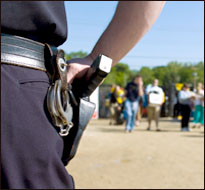The justice system relies upon eyewitness reports from law enforcement or citizens to prosecute and sentence criminal suspects, but faulty eyewitness identification is a common reason for a subsequent exoneration. Research on physical exertion’s impact on memory suggest that while low-level activity can facilitate remembering, higher levels may generate more “neural noise” in the brain and interfere with the memory process.
A 2012 study published in Psychological Science, “Witnesses in Action: The Effect of Physical Exertion on Recall and Recognition,” describes an experiment designed to measure the impact of physical exertion on memory and cognition. Twenty-four pairs of Canadian metropolitan law enforcement professionals were briefed on a series of recent armed robberies. In each pair, one officer (Officer A) exercised intensely and one officer didn’t (Officer B). The pair was directed to the residence of the primary suspect (the “critical target”). In each instance, an actor playing the critical target shouted at Officer A to leave his house; the encounter was repeated separately with Officer B. After a short delay, both officers answered questions about the briefing and reported details about the possible subject (“incidental target”), the known suspect (“the critical target”) and the scenario. Officers were finally shown a photographic lineup of possible suspects, including one of the critical target/actor, and asked to identify him.
Findings of the report include that:
- “Participants in the exertion condition made fewer correct responses to cued recall questions concerning the original briefing than did participants in the no-exertion condition.” The authors suggest that the memory consolidation process may have been somehow interrupted by the period of intense exertion in the middle of the experiment.
- When asked about the details of the briefing, 84% of the Officer B participants provided correct information, compared with only 52% of Officer A participants. “Participants in the exertion condition also provided fewer correct update details … than did control participants.”
- Officer A participants were able to identify the critical target from a lineup 27% of the time, while Officer B participants were able to correctly identify him 54% of the time. Additionally, 27% of Officer A participants reported that the target was definitely not in the lineup, compared with only 8% of Officer B participants.
- “There was no difference between conditions in the detection of weapons or in the number of weapons reported [at the scene], which suggests that attentional resources may have been diverted to risk-assessment activities rather than the encoding of the critical target.”
The authors note the importance of eyewitness testimony in judicial proceedings and suggest that the study’s findings speak to “a more generalized impairment” of memory. “The delivery of justice may depend on the statements and identifications provided by witnesses who have experienced physical exertion, either in the course of their occupational duties or due to the nature of the crime perpetrated against them. Such witnesses may be required to justify or rationalize deficits or inconsistencies in their accounts.”
Tags: cognition, crime, guns


Expert Commentary